Is A Snow Blower Worth It? Pros & Cons, How To Choose – Buying Guide
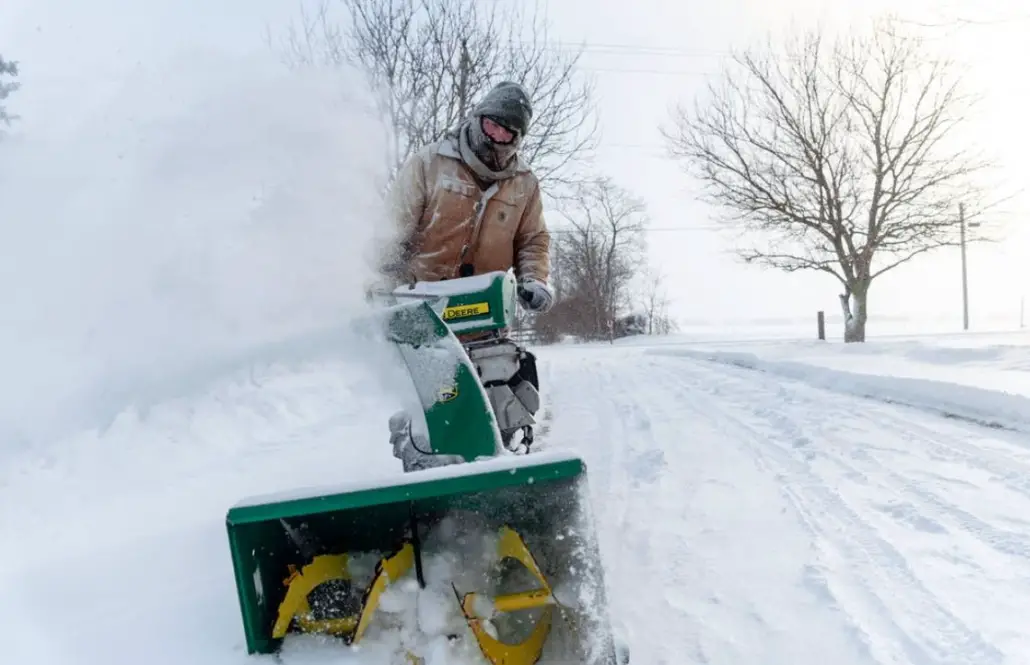
Mother Nature can really throw you for a loop and if you aren’t prepared, you could be in for a world of trouble. Large snow storms can trap your vehicle in your driveway and make navigating your property nearly impossible.
Plus, letting several inches of snow simply melt in place on your property can cause serious problems – ever have a foundation leak? The good news is that there are viable tools you can use to displace fallen snow.
No, we’re not talking about snow shovels. We’re talking of course about snow blowers. If you live in a snowy region of the country, these machines are must-owns. But choosing the right one can be tricky even if you have bought one before.
So in today’s guide we will be telling you about the different types, their pros and cons and how to choose the best one for your needs.
What is a Snow Blower and How Does it Work?
A snow blower is exactly what it sounds like: it collects snow from the ground and blows it out in a single direction so you can channel it any way you want it to go. They are used to remove snow from roads, driveways, sidewalks and anywhere else that poses an inconvenience.
These are motorized power tools and they work a bit differently depending on the type of machine you buy. In general though, these machines have two wheels and are pushed around by the operator – much like a walk-behind lawn mower.
There is an auger (a spiraled corkscrew blade) that collects the snow off the ground and moves it to the chute. The chute then blows out the snow and displaces it where the operator wants it to go.
When shopping for a snow blower, you should consider the size of the area that needs to be cleared. You should also think about the type of snow that you need to displace (hard, powdery, wet dry). Another important consideration is how much snow fall you usually get (inches).
Quick Guide Overview

How do I know what size snow blower I need?
If you are dealing with 8 inches or less, a single-stage blower would work fine. For 10 to 18 inches, a larger 2-stage blower would work best. For 20 inches or more, a 3-stage blower would do the job.
What features to look for in a snow blower?
Some of the essential features are the dead man’s control which stops the auger from spinning if the handlebar grips have been let go of by the operator, airless tires that navigate snow better and multiple speeds that make it easier to maneuver in the snow.
Is A Snow Blower Worth Buying?
If you live in an area that gets 8 inches or more in the Winter, then yes, absolutely.
What Are They Different Types Of Snow Blower
In general, there are 5 different types of snow blowers: electric blowers, single-stage blowers, two-stage blowers, three-stage blowers and track-drive blowers. Let’s take a closer look at each:
Check Out Our Best Snow Blowers For The Money Here – (New Tab)
Electric Snow Blower
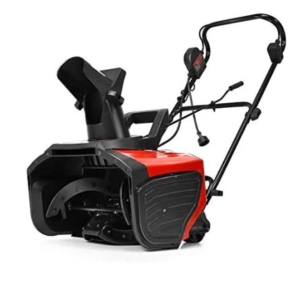
Electric snow blowers can run off of a power cable/extension cord or can be battery operated for cordless freedom.
Pros:
- Price – Electric snow blowers tend to be made from lighter-duty materials so they cost less than others.
- Good for Light Snowfall – In general, you can use an electric snow blowers to tackle up to 12 inches of snow.
- Lightweight Design – Because the parts are lighter and the machine is smaller, these blowers are easier to move around.
Cons:
- Longevity – You have to consider how long these flimsier machines are going to last.
- Corded Operation – While they can be battery operated, some models are corded which limits range.
It should also be noted that electric blowers work well on decks and steps that are hard for larger blowers to access. Their clearing width is typically 12-18 inches and they work best on level surfaces. This would be a great option for anyone who lives in a region that gets light snowfall.
Single-Stage Blowers
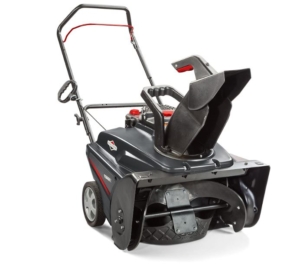
A single-stage blower scoops snow directly off the ground with and auger and pushes it through the chute in one motion hence the name. These are gas-powered blowers that make contact with the ground so you should use them on smooth, paved surfaces only.
Pros:
- Great for Moderate Snowfall – Single-stage blowers are good for clearing up to 18 inches of snow.
- Good for Wet Snow – The gas-powered action is more powerful than electric blowers so they are good for heavier, wet snow.
- Unlimited Range – Since these are gas-powered and not corded, you can move freely about your property.
Cons:
- More Maintenance – These types of blowers require gas refills and intermittent oil changes.
- Not Good for Graveled Surfaces – These models will fling gravel with the auger so they should only be used on paved surfaces.
The usual clearing width for single-stage blowers is between 18 and 20 inches and can only handle slight inclines. These would be best for people who get moderate snowfall.
Two-Stage Snow Blower

Two-stage blowers work with an auger that moves the snow up to an impeller. Then, the impeller discharges the snow out of the chute. The two motions make for fewer snow clogs and keeps the snow moving at all times.
Pros:
- No Direct Contact – The auger does not make contact with the ground so it can be used on graveled surfaces.
- Taller Buckets – The taller buckets can help you tear down snow buildups while you displace snow.
- Fast – The clearing width of these types of blowers is usually between 20 and 38 inches so they can help you get the job done quicker.
Cons:
- Heavy – These are heavier machines so not everyone will be able to operate them nimbly.
- Throwing Snow – These babies can throw snow up to 60’ which means you have to be more careful when operating them
Two-stage blowers can handle moderately steep to steep inclines so they would be a good choice for anyone that has a moderately inclined driveway.
Three-Stage Blowers
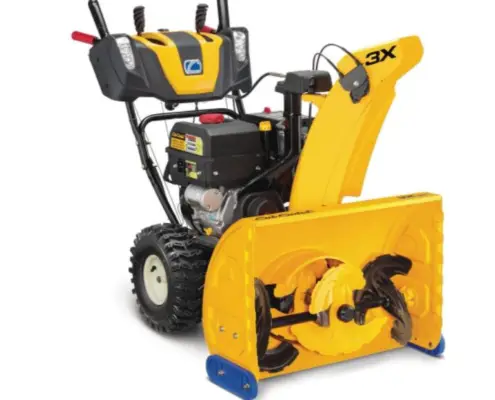
Three-stage blowers have an impeller that actually cuts up snow and ice and then feeds it to the chute. There are also 2 metal augers instead of a single auger. They can clear snow that has built up to 23 inches.
Pros:
- Powerful – These are some of the most powerful residential blowers on the market and are great for ice.
- Heavy Snowfall – Three-stage blowers are great for heavy, wet snow as the impeller chops up hard ice and snow.
- Paved or Gravel Surfaces – These blowers can be used on both paved and gravel surfaces as the augers don’t touch the ground.
Cons:
- High Price – As some of the most powerful blowers on the market, you can expect to pay a hefty price.
- Gas Usage – It takes a lot of gas to power three-stage blowers so it could cost you more in fuel usage.
Like two-stage blowers, three-stage blowers work well on moderately steep to steep inclines. They are best for properties that get heavy and wet snow buildup. The common clearing width for three-stage blowers is between 24 and 30 inches. They also come with a variety of features like heated handles.
Track-Drive Blower

Track-drive blower operate just like two and three-stage blowers but the wheels are different. They have wheels like a tank so you get more traction and control from the wheels.
Pros:
- Better Traction – These types of blowers work great in heavy snow and will give you more stability.
- Very Powerful – Track-drive motors can handle snow that has built up to 23+ inches.
- Best Choice for Ice – Since the track wheels offer better traction, these blowers are safer to use on ice.
Cons:
- Expensive – These tend to be some of the most expensive multi-stage snow blowers on the market.
- Throws Snow Far – You better have a lot of space to work with because these machines can throw snow up to 60 feet.
Track-drive blowers work great on paved and graveled surfaces and can handle steep inclines. They would be good for anyone who gets icy snow and has a dynamic property in terms of hills and inclines.
Electric Snow Blower vs Gas
Electric snow blowers work best on smaller properties that see light snowfall. They’re great because you don’t have to fill them with gas or change their oil. Gas blowers require more maintenance but give you more freedom of movement. Gas blowers would be better for moderate to heavy snowfall.
Single-Stage Snow Blower Vs Two-Stage
A single-stage blower would be great for moderate snowfall or any paved surfaces. Two-stage blowers don’t make contact with the ground so they are safer on gravel. However, a single-stage blower isn’t very powerful and two-stage mower will be more expensive. A two-stage blower will be worth it if you get around 23 inches of snowfall
Two-Stage Vs Three-Stage
A three-stage blower will be better if you deal with hard, icy snow. A two-stage blower is better for wet snow.
Snow Blower vs Leaf Blower
A leaf blower uses propelled air to move leaves around while a snow blower uses and auger and impeller. You may be able to use your snow blower to move leaves if you have a single-stage blower and you don’t use it on a windy day.
Self-Propelled Vs Push Snow Blower
Self-propelled blowers are lighter weight and can move forward by themselves which makes them a great choice for inclined surfaces. However, push blowers are more powerful but they are heavier and may be difficult for people with mobility issues.
Snow Blower Vs Snow Thrower
Snow throwers work the same as single-stage blowers so they are less powerful than multi-stage blowers. They are best for light snowfall while a snow blower would be best for moderate to heavy snowfall.
Snow Plow Vs Snow Blower
A snow plow is a curved or angled blade that can be attached to the front of a vehicle to displace large amounts of snow. A snow plow is great for removing snow from the gutters, large driveways, parking lots and large properties. A snow blower doesn’t work as fast as a snow plow but better for clearing driveways and other residential applications.
Snow Blower Vs Shovel
A snow blower will make quicker work of your snow clearing job but will surely cost more. Shoveling is fine for light snowfall but it can be very taxing on the body.
Snow Blower Vs Electric Shovel
An electric snow shovel usually has a 12” clearing path but displaces snow in much the same way as a blower. They can be battery powered and are great for use on stairs and other hard to reach areas. However, they are less powerful and can’t handle heavy snow. Snow blowers work fast and can handle wet, heavy snow. Though they can’t reach tight spaces and are more expensive.
Tips For Running A Snow Blower
- Be sure to wear safety glasses
- Make multiple passes of the same area
- Adjust the chute so it blows snow where you want it to go
- Clear debris from the path like newspapers and rocks
- Take smaller paths (about one half of the clearing width) to avoid clogs
- Use fresh fuel to make the machine easier to start
- Let the engine cool before refilling it with gas
What Are The Best & Most Reliable Brands Of Snow Blower Available?
Some of the most reliable brands of snow blowers include:
Snow Blower FAQ’s

Q: Are snow blowers hard to use?
If maintained properly and you get one that is light enough for you to push, they are not hard to use. Also, consider self-propelled models for inclined areas.
Q: How long do snow blowers typically last?
A properly maintained snow blower (gas, single or multi-stage) should last several years. You can expect 10-25 years of use!
Q: Is it OK to leave snow blower outside?
You can but you have to make sure it is elevated off the ground, sealing off the chute and covering the whole machine with a heavy tarp.
Q: Can a snowblower be left in the rain?
You should avoid leaving your snow blower in the rain as much as possible but if it can’t be avoided, make sure it is completely covered.
Q: How many cc should a snowblower have?
It will depend on your needs. For smaller properties, a 200cc engine should be fine. For medium-sized jobs, 300cc engines will be needed. For large blowing capacity, go with a 400cc engine.
Q: Is Wider snow blower better?
Yes and no. Wide blowers can help you get the area cleared faster but you also risk clogs.
Q: How many inches of snow do you need for a snowblower?
Typically, you don’t want to use a snow blower for anything less than 8 inches of snow.
Q: Is a 24 inch snow blower big enough?
24 inches is fine if you don’t mind making 5-10 passes and your property is small to medium.
Q: Can you use a snowblower while its snowing?
It is best to let the snow settle before using your blower.
Q: What is better battery or gas snow blower?
Both give you unlimited range but gas-powered blowers tend to offer more power. However, batteries can be recharged which is better for the environment and could save you money. Consider battery-operated blowers for smaller properties and gas-powered blowers for larger clearing jobs.
Q: How do you clear snow from a snowblower?
Turn the machine off and let it sit for at least 10 seconds. Then use a broom handle or the chute cleaner tool your blower came with to remove the clog from the chute.
Q: How Loud Are Snow Blowers?
Electric blower will be the most quiet option while some gas-powered blowers can operate at 90 decibels.
Q: Do you need hearing protection for snow blower?
It is advisable to wear ear protection when operating any power tool including snow blowers.
Q: How do you move a snow blower?
You can use a ramp to help you if your blower is too heavy but they have wheels so they shouldn’t be too hard to push into position.
Q: What happens if you don’t shovel snow?
Not removing snow from a driveway can expand cracks and damage the pavement.
Q: When should you not shovel snow?
You should not shovel snow if you have mobility or joint issues or if you are above the age of 45.
Q: What Is The Most Reliable Snow Blower?
We really like the Toro SnowMaster 824 QXE because it works fast and more effectively than some more expensive blowers.
Final Thoughts
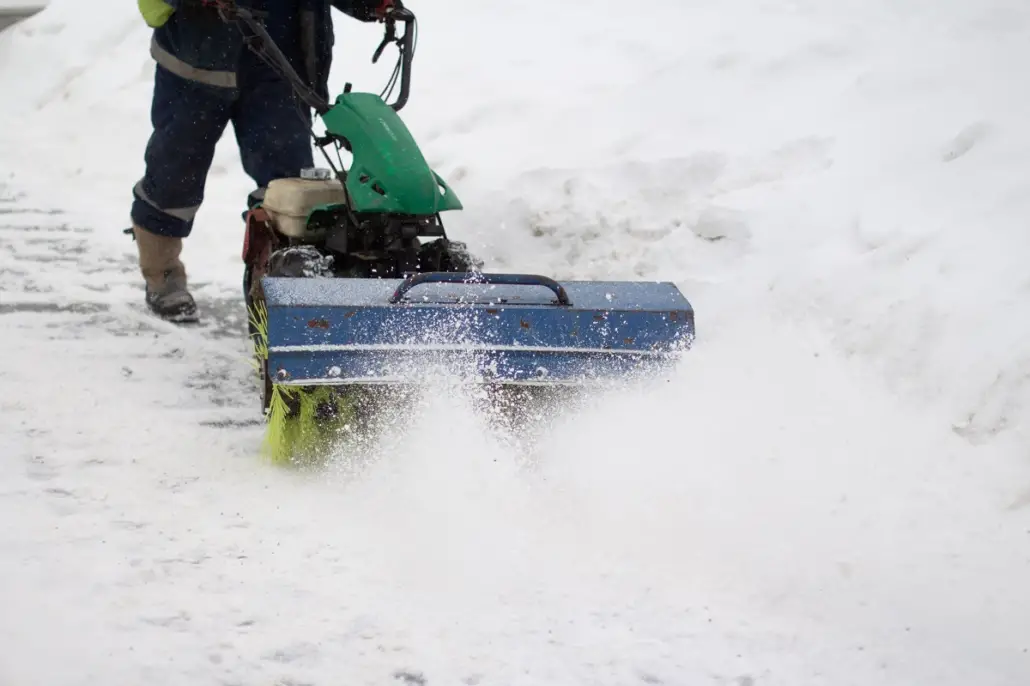
Choosing the right blower can be the difference between a fun chore and back-breaking labor so take a careful look at the types of snow blowers in our guide!


